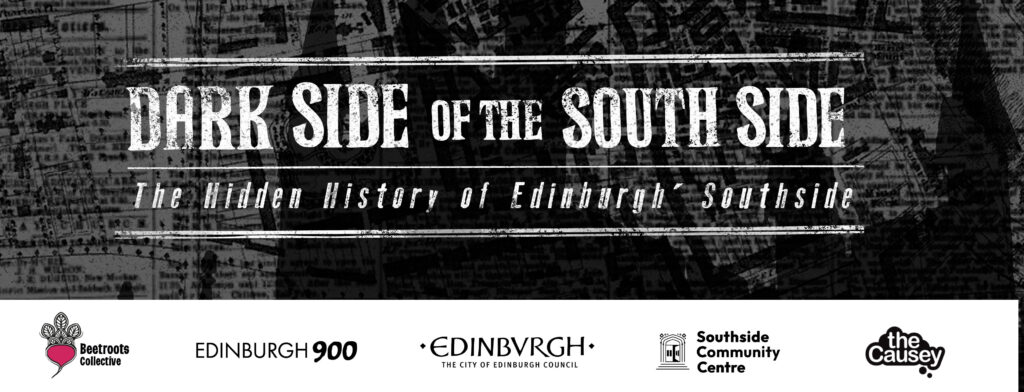
Dark Side of the South Side is a heritage community art project created by Beetroots Collective for Edinburgh 900, and inspired by the research of a local Edinburgh Southside historian and writer, Diarmid Mog.
Leading artists Marta Adamowicz and Robert Motyka organised art workshops, where participants created illustrations for a local history exhibition while discussing history, lore and legends of Edinburgh’s Southside with Diarmid Mogg. The workshops were a great way to get to know the neighbourhood and its dark secrets, and provide a route to discover the history of buildings that are still standing or might have long ago perished.
The 2025 edition of the project was presented as an outdoor exhibition in the heart of Newington, on the Southside Community Centre.
Marta Adamowicz is an award-winning multi-disciplinary artist and illustrator of Polish origin, based in Glasgow. Her artwork has been a part of many, prestigious festivals and exhibitions in Scotland and London. Her work is concerned mainly with social issues and the natural world.
Robert Motyka is an award-winning Projection Artist, Video Creator and Lecturer with over 20 years of experience in the creative industry. He’s a human rights activist supporting migrants’ rights and the Polish LGBT+ community.
Diarmid Mogg is a writer and researcher in Edinburgh. He is the author of the websites Tenement Town (tenementtown.com), and the award-winning Small Town Noir (smalltownnoir.com), which tells the life stories of the ordinary people featured in a cache of old mugshots from one small Pennsylvanian town. He is currently writing a non-fiction book about the lives of the people involved in a 1905 murder in a Glasgow tenement.
Participants of the project:
James Barrass, James Blackthorne, Justine Blair, Helene LJ Combes, Alastair Cattanach, Zoe Cumming, Valentina Fritis, Alina Litvinova, Julie Logan, Jude Quartson-Mochrie, David Mogg, Freyda Mogg, Norlyne Rosewarne, Judith Sandeman, Miedina Yelisova, Becky Yu
THE PRESTON STREET GIBBET
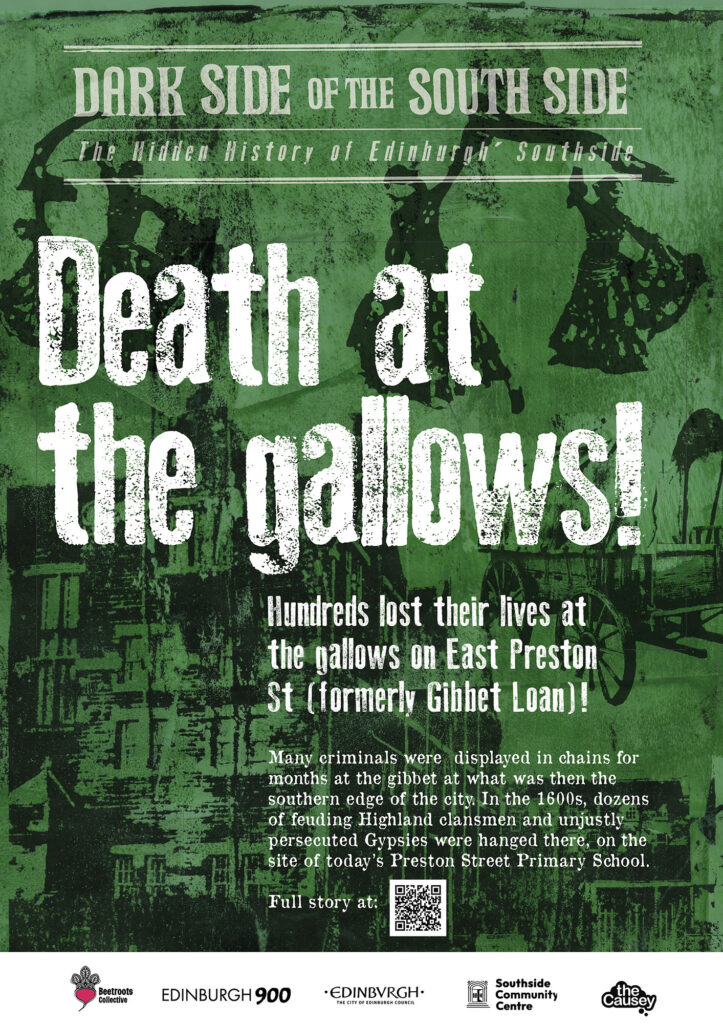
If you were a 16th or 17th century traveller coming into Edinburgh from the main road from the south, one of the first signs that you had reached the city’s outskirts would have been the sight of decaying corpses hanging from a structure on the high point of the burgh muir, built on what is now the playground of Preston Street Primary School.
The gibbet was built in 1586 with stone pillars connected at the top by cross-beams of wood, with stone walls erected around the structure “so that dogs shall not be able to carry off carrion as they have done in times past”.
For over a century, the gibbet was the permanent place of execution in south Edinburgh, and here great numbers of unfortunates perished, often in batches from two to nine. The place was considered infamous, and a death there was a shameful one. The corpses of people hanged at the gallows in the old town were often transported there to be hung in iron chains, to cast additional shame on them.
Clan feuds in the Borders and the Highlands often ended in murder, and the murderers often ended up on the gibbet. In the first two decades of the 1600s, forty-three members of the Highland Clan Macgregor were hanged there for murderous raids on the Clan Colquhoun near Loch Lomond.
Perhaps the darkest period of the gibbet’s existence, however, was under James VI, who ordered the expulsion of all Gypsies from Scotland, on pain of death, on account of “the gret thiftis and scaithis done be the saidis Egiptianis upon our lordis liegis” (the great thefts and damage done by them to the public). A sort of ethnic cleansing.
Any subject was allowed to imprison and hang any Gypsy as a common thief, and many of their lives ended on the gibbet. In 1611, four Gypsies, all with the surname Faa, were arrested for “presuming to remain in the Kingdom”, and were hanged there. In 1624, twenty Gypsies—men and women—were arrested in East Lothian. Eight of them, including their captain, John Faa, were sentenced to be hanged on January 28th. An immense crowd assembled and there was a violent attempt at rescue. A historian writes: “There arose such a shouting and crying among the multitude, and the confusion and disorder was so great that one of the Gypsies, called Gavin Trotter, was cunningly conveyed away and the cords that bound him were cut.”
The remaining men were hanged the next morning. The women were sentenced to be drowned, but were ultimately banished from the country.
In 1650, General Montrose (commander of royalist troops in the English and Scottish civil wars) was executed and dismembered. His head was stuck on a pike on St Giles Cathedral, his limbs sent to be displayed in Scottish cities. His mutilated torso was buried beneath the gibbet. His niece sent men to remove his heart, which she kept in a gold box. In 1661, after the restoration of the monarchy, his body was exhumed and reunited with his limbs and head. He was given a lavish state funeral, and now rests in St Giles Cathedral.
In 1675, the council decreed that the only place of execution in Edinburgh would be in a meadow near Holyrood, and the gibbet was thereafter used as a place to display prisoners in chains. A few decades later, it was dismantled, and the ground turned into a sports field for the university. And now children of the Southside play there, never giving a thought to what lies beneath their feet.
THE DR KNOX RIOT
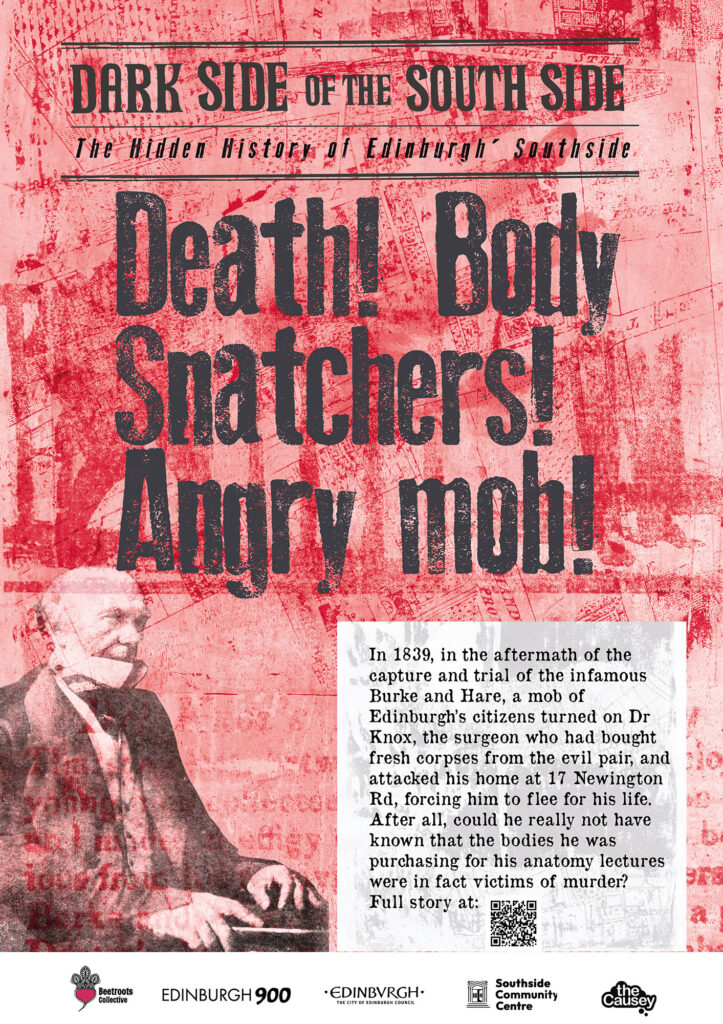
Everyone knows the story of Burke and Hare: how, in the late 1820s, those two Irish labourers made easy money by selling fresh corpses to the anatomist Dr Robert Knox—corpses they obtained by murder. They killed at least 16 people before they were caught. Hare escaped the noose by turning state’s evidence and was imprisoned for a period, while Burke was hanged.
Knox had been an army surgeon in the Napoleonic wars and had returned convinced that a greater knowledge of anatomy among surgeons would save countless lives. He was a flamboyant and popular lecturer, and there was great demand for his classes—which is, of course, what led to his great need for corpses to dissect.
The connection to the Southside comes about through the public’s outrage towards Dr Knox, who people believed must have at least had suspicions about where the bodies were coming from, and at worst—which is probably true—knew fine well, but seemed to have escaped punishment entirely, due to his eminence and connections.
After Burke’s execution, a great crowd of people assembled in the old town and marched up Leith street and the Bridges, heading towards Newington, where Knox lived in a Georgian terrace house (on Newington Road, just beyond East Preston Street—behind what was until recently a dry cleaners). A report stated: “They carried an effigy of a certain Doctor, who has been rendered very obnoxious to the public by recent events. The figure was pretty well decked out in a suit of good clothes, and the face and head bore a tolerable resemblance to the person intended to be represented. On the back was a label bearing the words “Knox, the associate of the infamous Hare.”
“The crowd, which increased rapidly, proceeded onward to Newington, where the figure was suspended by the neck from a tree, fire being also put to it, but which soon went out. The figure was then torn to pieces, amidst the loud huzzas of thousands. Up to this period no actual violence had been committed, but the appearance of the crowd was very threatening, the whole flower-plot and railing in front of the Doctor’s house being literally packed with people, who were shouting in a wrathful manner, blending the names of the West Port murderers with that of the medical gentleman so often alluded to, as connected with those horrid transactions.”
The house was pelted with stones, the windows smashed. Before the police eventually dispersed the crowd, Knox escaped through the back door and passed unrecognised through the crowd, and all the way down Clerk Street to the house of his friend in St Patrick Square. His friend was impressed by his composure, but Knox drew aside his military cloak to reveal that he had taken no chances, having armed himself with a sword, two pistols and a Highland dirk.
Knox attempted to return to teaching, but was shunned by the medical establishment and found himself unable to work in Scotland. He ended up in London, in a lowly position as a pathologist in a free hospital. He died three decades later and, because his connection to the shocking crimes was still too much within living memory, was buried in an unmarked grave.
THE GREAT LAFAYETTE
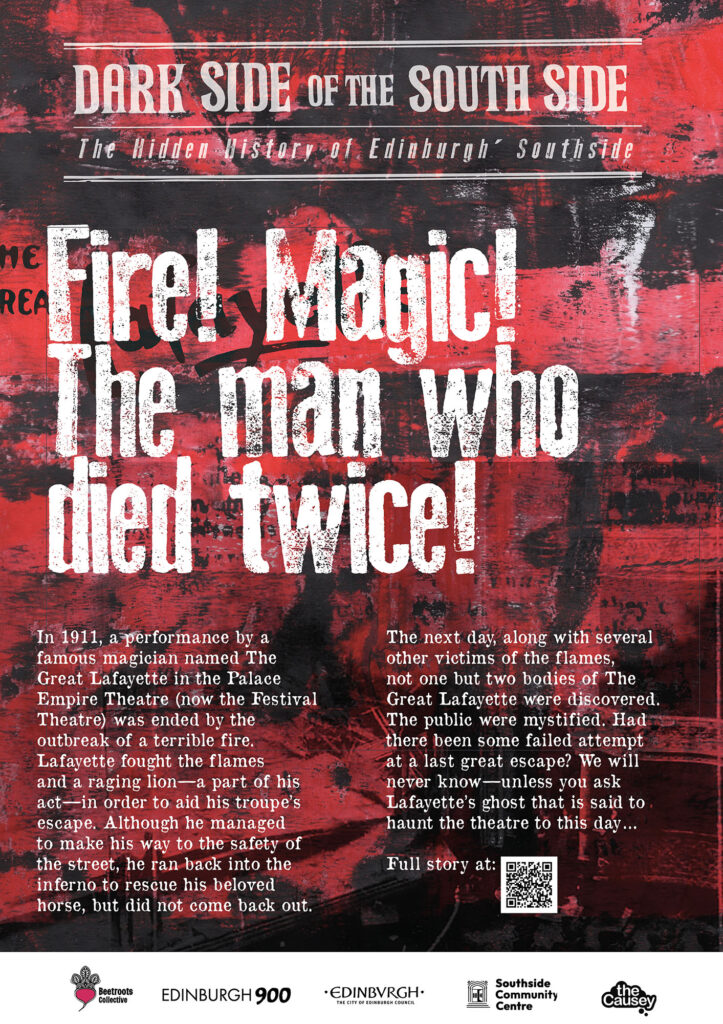
The Great Lafayette was the most successful stage magician of the early 20th century, greater even than Houdini. And he loved his dog.
A newspaper wrote: “In his personality, Lafayette is dominating and peculiar to a degree. His most remarkable trait is his extraordinary affection for his dog, Beauty. Beauty is a cream colored Tennessee hound which appears in his performance and Lafayette demonstrates his love for the animal in bizarre manner. He had a gold collar studded with diamonds made for Beauty. On his personal cheques is a picture of Beauty sitting on bags bursting with gold, above the words, ‘My two best friends.’”
He indulged the dog terribly. Beauty shared five-course meals with Lafayette in fine restaurants and, when it wasn’t travelling in Lafayette’s Mercedes, which had a silver statue of the dog as its hood ornament, it was transported in a special room in Lafayette’s private train coach that was fitted with miniature doggy luxuries.
On 30 April, 1911, Lafayette, Beauty and their company arrived in Edinburgh to begin a two-week engagement at the Empire Palace Theatre—now the Festival Theatre. However, shortly after the run began, Beauty died—cause unknown. Lafayette was heartbroken. The dog was embalmed at Surgeons’ Hall and laid out on silk cushions, surrounded by lilies, in Lafayette’s suite in the Caledonian Hotel.
Lafayette bought a burial plot for Beauty in Piershill cemetery, in the centre of the great rotunda by the entrance, but discovered that he was not allowed to bury an animal in consecrated ground. He told the cemetery that, in that case, he would keep the grave for himself and have the dog buried with him there when he died.
Which turned out to be sooner than expected.
The last act of Lafayette’s spectacular stage show was an illusion called the Lion’s Bride, which was set in a harem and involved a real lion menacing an oriental maiden after appearing to devour the magician.
Just after the scene’s climax, which featured the magical transformation of the lion into the resurrected Lafayette, a fire broke out on stage.
The audience fled but the members of the company had more difficulty escaping, mostly because the exit from the stage was blocked by a huge, panicked lion — I picture it pacing angrily back and forth at the stage edge with flaming curtains and scenery falling all around, its mane smouldering as cinders land on it, and roaring furiously at the group of exotically dressed people it can see creeping towards it through the choking smoke.
A newspaper claimed that “Lafayette had a desperate struggle with the beast before he got him out of the way”, but that might be fiction. In any case, most of the company somehow managed to get out, including Lafayette. However, once he was out on the street, he remembered that his horse, which had had a role in one of the acts, was still inside, and ran back into the theatre to save it.
He didn’t come back out, and the theatre burned for three more hours.
Among the 11 bodies that were eventually discovered, there were found to be two Lafayettes—that is, two bodies dressed in the Pasha costume that Lafayette had been wearing in the last act.
The first to be found—which had been assumed to be the one and only Lafayette and had been sent to a mortuary and cremated before the second was uncovered—was a double who stood in for Lafayette as part of the Lion’s Bride illusion. The second body was certainly Lafayette, as it was wearing his diamond rings.
Lafayette was Jewish (his real name was Sigmund Neuberger), but Edinburgh’s rabbi refused to conduct any ceremony in which a man and a dog would be buried together, so the service was conducted by the local minister, and Lafayette’s ashes were buried in a casket between Beauty’s paws.
His manager told the newspapers that Lafayette had always said, “If Beauty dies, I shall die too within a few days.” He had assumed it was just a turn of phrase, but perhaps it was more than that, and the great magician indeed predicted his own death.
THE ZEPPELIN RAID OF 1916
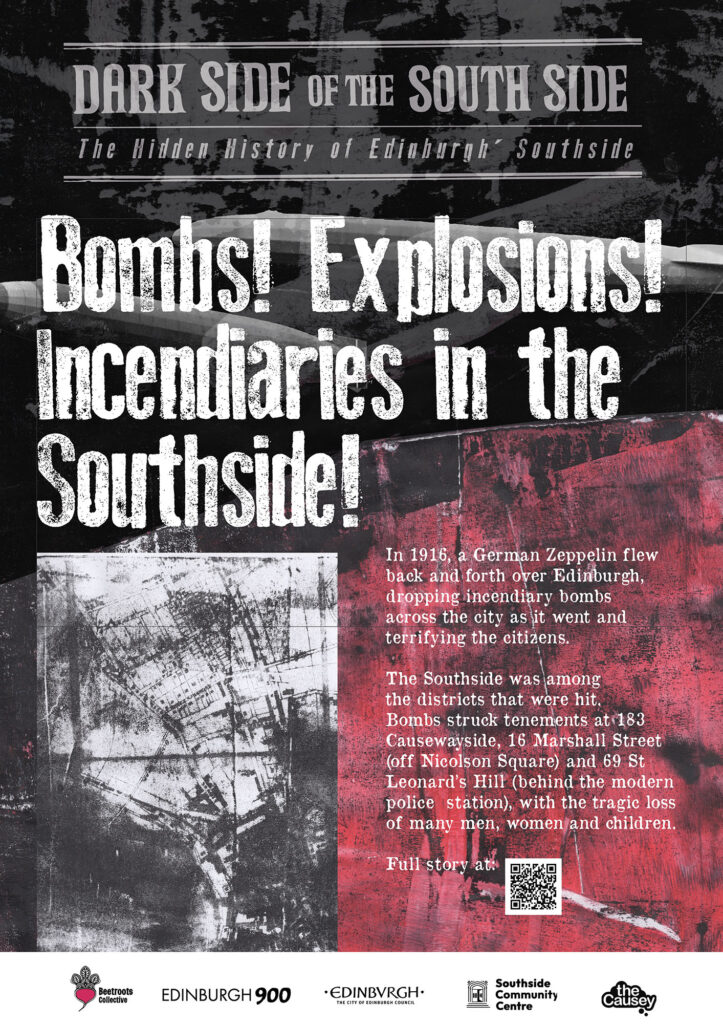
As darkness fell on 2 April 1916, Edinburgh received a warning message that a German Zeppelin was heading to the city with the intention of carrying out a bombing attack like the ones that had struck English cities in recent months. The city’s electric lights were dimmed and the tramway stopped. The fire brigade and hospitals were put on alert.
The Zeppelin, under command of Kapitän-Leutnant Alois Böcker, who knew the city from visits before the war, when he was a sailor, approached from the Forth and flew towards the centre of Edinburgh, dropping incendiary devices as it went.
It flew back and forth over the city for just over an hour, seemingly trying to hit the castle. In all, 44 bombs were dropped, and 14 people were killed, many in the southside.
The bombs fell on these Southside buildings:
Haddon’s Court (behind Nicolson Street Tesco), three people were injured and McCallum’s Spirits Merchants store was destroyed, including all stock. James Farquhar, a 73-year-old mason, died in hospital from injuries.
69 St Leonard’s Hill (behind the police station, beside Jeanie Dean’s). Four-year-old Cora Bell, a wine warehouseman’s daughter, who was sleeping in her bed, was killed, and her mother, Isabella, was injured.
183 Causewayside, “a working class tenement, single and double-room flats”. Six were injured—cuts and burns, mostly slight—and the interior of the building was wrecked.
And
16 Marshall Street (off Nicolson Square), again, “a working class tenement”. A bomb fell on the pavement just outside the stair door. Residents had gathered in the passageway of the building, probably up and about due to the excitement of the Zeppelin’s presence in the skies. The blast was driven into the stair, killing seven and injuring seven. The dead were: William Smith (15 years old), a waiter; John Smith (41), a tinsmith; Henry Rumble (17); David Graham (five years old); William Ewing (23), a hairdresser; and Victor McFarlane (24), a waiter. Private Thomas Donoghue (24), home on leave, died of severe wounds a few days later.
The news was allowed to report that there had been an attack in the east of Scotland, but was forbidden to say exactly where or to mention that anyone had died. The Scotsman said: “the raid… naturally caused some excitement, but failed to produce any panic or do otherwise than steel the hearts of the people against the nation capable of using such barbarous methods of warfare against the civilian population.” It also took the opportunity to strike a patriotic note: “Scottish stone proved more resisting than English bricks; instead of the crumbling ruins of houses … the only evidence of the raid on the tough fabric of Scottish buildings was shattered windows and indentations on the walls. This first raid on the coasts of Scotland has been a great triumph for the Scottish builder.”
Kapitän-Leutnant Böcker was captured later that year when his Zeppelin was shot down over Essex, having flown 17 bombing missions and killed up to 200 people. He spent the rest of the war as a prisoner, and returned home upon his release.
Helen Pairman
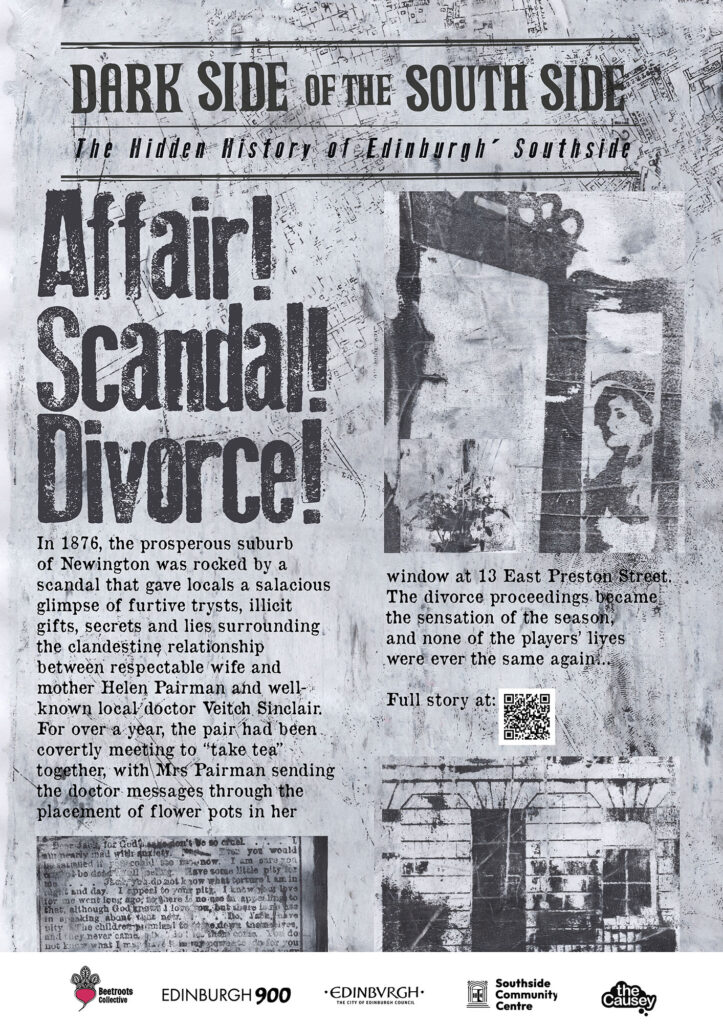
Helen Pairman—then Adams—married John Pairman, an illustrator for Chamber’s publishing house, in 1859, when she was 20. By 1876, she, John and their four young boys were living in a flat in 13 East Preston Street. And Helen was full of secrets.
One secret that she kept from her husband was that, for years, she had suffered from what her doctors called a uterine disease, which caused her intermittent but excruciating pain in her abdomen and back.
One doctor diagnosed cancer. Another—the eminent Dr James Young Simpson—said that it was unlikely to be cancer, but that she would be unable to have any more children. That was after her second child, and before her third and fourth.
(Her condition was almost certainly what we now call endometriosis.)
She drank spirits, heavily, when the pain became unbearable—usually every month or two. (That was another secret.) She raised money to pay for it by giving the maid valuables to pawn. (Yet another.)
Her most important secret, from which lots of other supplementary secrets would spring over the years, was the close relationship she developed with the only doctor whose methods appeared to help her to any degree, Dr Veitch Sinclair.
Dr Sinclair, 60 years old when they met in 1869, had an established practice in the New Town and visited patients across Edinburgh. Under his treatment, Helen’s condition improved rapidly. It was arranged that the doctor would drop in whenever he was in the Southside.
His visits were frequent, twice a week for a year, until the day Helen told her husband that she believed the doctor had tried to kiss her, and Mr Pairman told him his services were no longer required.
Soon after, however, Helen got word to Dr Sinclair that she needed him to treat her again, but that they must not let her husband know. The doctor agreed to return, and was soon visiting the flat for an hour or two, three or four times a week, always when Mr Pairman was at work.
Helen gave the doctor tea, sending her oldest boy out for cakes and cream. She served the doctor herself; the maid was not allowed in the room. The children were also forbidden to enter when the doctor was there.
They discussed books they were reading. He told her news of his patients, from members of Edinburgh society to the prostitutes he was occasionally called on to attend to.
He brought her gifts—a chatelaine, a fan. When she lost a ring, he brought her a new one. When she said she was worried that her hair was thinning, he brought her a hair brush.
There is no evidence that they did anything other than pass the time in pleasant conversation. But people talk—people like Helen Pollock and her mother, for instance, who lived directly opposite the Pairman’s flat, at number 22.
They often saw Dr Sinclair coming and going—“Our attention was attracted by the length of time he stayed”—and noticed that a flower pot would appear at the parlour window before his visits. (Helen’s children noticed that their mother sometimes moved it there, too. They didn’t know why.)
The maid, Flora McLauchlan, talked, too. She said that, when Dr Sinclair first came to visit, the visits took place in the parlour, but latterly they were in the dining room, from which there was a door to a bedroom.
She said Dr Sinclair arrived with flowers for Mrs Pairman hidden in his hat.
She said Dr Sinclair showed Mrs Pairman a book with obscene pictures, which Mrs Pairman described to her.
She said Mrs Pairman told her she had tickled the doctor’s whiskers, had kissed him, had sat upon a stool at his feet and cuddled him.
She said none of this to Mr Pairman, who knew nothing about it.
On three occasions, Mr Pairman happened to return home when the doctor was in the flat. Once, the doctor slipped out while Mr Pairman was taking off his coat in a room off the lobby, but on the other occasions there was a confrontation with the doctor and a tremendous row with Helen.
He would shout things like, “Do you think a man who would come to the house after being ignominiously dismissed from it is a fit man for you being friendly with?” Helen would sob. The children would hide under their beds.
Helen took to arranging rendezvous with Dr Sinclair out of the flat. They strolled in Newington Cemetery. They walked to Portobello, where they twice took tea in a private room, which, by chance, had a bedroom off it.
(The proprietress of the hotel said, “I thought they were husband and wife because he was so polite to her. The way he handed her down the stairs—I don’t often see such attention from a husband.”)
(Dr Sinclair was 67 at this time; Helen 38.)
Eventually, Helen rented an attic room at 5 Chambers Street, using a false name, and furnished it with a bed, chairs and everything that was needed for two people to have tea together. Or do various other things.
It worked perfectly for a month—all of May, 1876—until Flora McLauchlan, the maid, discovered a mysterious set of keys wrapped in a cloth in Helen’s room and followed her the next time she went out. She showed the keys to Mr Pairman, and told him what she had seen.
That week, Mr Pairman, along with a sheriff’s officer and two other hired men, watched Dr Pairman and Helen and followed them to their secret flat. After a minute or two, they forced open the door and burst in.
There were shouts, denials. The doctor burst into tears. Mr Pairman struck him on the forehead, drawing blood. The doctor fled from the flat with Mr Pairman roaring, “You old b_____! I’ll give it to you!”
Mr Pairman initiated divorce proceedings the very next day. The hearings lasted a month, and ended with the judge granting the divorce. Dr Sinclair was ordered to pay the costs, and had to sell his house and furniture to do so. His wife went to live with one of their sons in Edinburgh. The doctor, bankrupt, went to live with another son in London.
John Pairman moved, with the couple’s four children, to a house in Portobello.
Helen went to live in her mother’s flat in a decaying tenement in Dumbiedykes. She never saw her children again.
THE CAUSEWAYSIDE V GEORGE SQUARE BICKERS
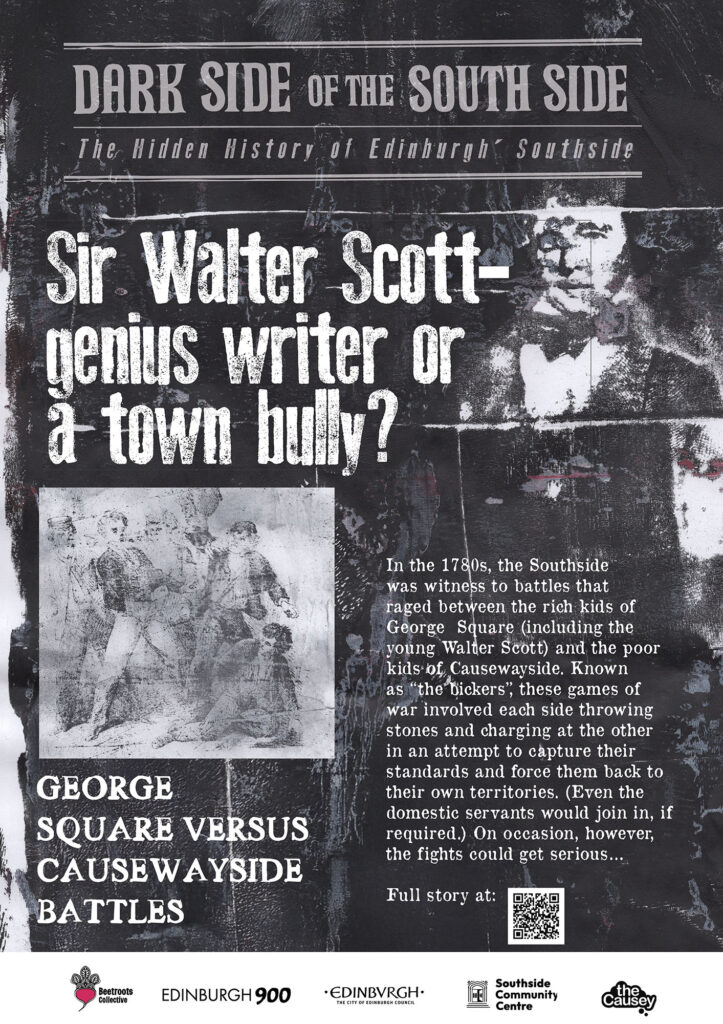
Walter Scott tells of the running battles that boys in the Southside engaged in during the 1780s, when he was young.
“The boys belonging to George square (where Walter Scott grew up), were arranged into a sort of company, to which a lady of distinction presented a handsome set of colours. Now this company or regiment, as a matter of course, was engaged in weekly warfare with the boys inhabiting the Crosscauseway, Bristo-street, the Potterrow – in short, the neighbouring suburbs. These last were chiefly of the lower rank, but hardy loons, who threw stones to a hair’s-breadth, and were very rugged antagonists at close quarters. The skirmish sometimes lasted for a whole evening, until one party or the other was victorious, when, if ours were successful, we drove the enemy to their quarters, and were usually chased back by the reinforcement of bigger lads who came to their assistance. If, on the contrary, we were pursued, as was often the case, into the precincts of our square, we were in our turn supported by our elder brothers, domestic servants, and similar auxiliaries.”
He recounts one particular incident, featuring what would now be considered an extremely serious injury, involving a boy from the Cross Causeway known as Green Breeks.
“From our frequent opposition to each other, though not knowing the names of our enemies, we were yet well acquainted with their appearance, and had nicknames for the most remarkable of them. One very active and spirited boy might be considered leader in the cohort of the suburbs. He was thirteen or fourteen years old, finely made, tall, blue-eyed, with long fair hair, the very picture of a Goth. This lad was always the first in the charge and last in retreat – the Achilles and Ajax of the Cross Causeway. From an old pair of green livery breeches which he wore, he was named Green Breeks.
“Once, when the combat in the meadows was at the thickest, this champion headed a sudden charge, so rapid and furious that all fled before him. He was several paces before his comrades, and had actually laid his hands on our standard, when one of our party, whom some misjudging friend had entrusted with a hunting knife, struck poor Green Breeks over the head with sufficient strength to cut him down. When this was seen, the casualty was so far beyond what had ever taken place before that both parties fled different ways, leaving poor Green Breeks, with his bright hair plentifully dabbled in blood, to the care of the watchman.
“The bloody dagger was flung into one of the meadow ditches, and solemn secrecy sworn on all hands; but the remorse and terror of the boy who had struck the blow were beyond all bounds, and his apprehensions of the most dreadful character. The wounded hero was for a few days in the infirmary; but though inquiry was strongly pressed on him, he would not tell from whom he had received the wound, though he must have been perfectly well known to him.
“When he recovered, the actor opened a communication with him, through a popular gingerbread baker, with whom both parties were customers, in order to tender recompense in the name of smart-money. I am sure that the pockets of the noted Green Breeks never held so much money of his own, but he declined the remittance, saying he would not sell his blood; but at the same time repudiated the idea of being an informer, which he said was clam – that is, base or mean. With much urgency he accepted a pound of snuff for the use of his aunt or grandmother with whom he lived.
“We did not become friends, for the bickers were more agreeable to both parties than any other peaceful amusement; but we conducted them ever after under mutual assurances of the highest consideration for each other.”










